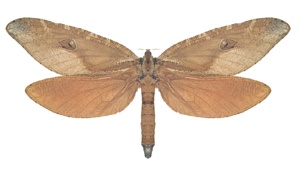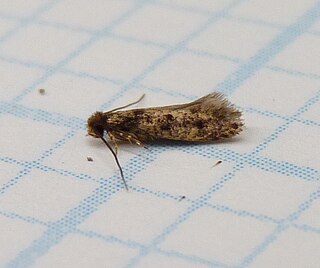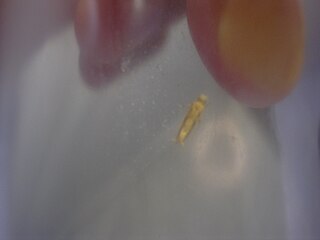
The Hitchhiker's Guide to the Galaxy is a comedy science fiction franchise created by Douglas Adams. Originally a 1978 radio comedy broadcast on BBC Radio 4, it was later adapted to other formats, including novels, stage shows, comic books, a 1981 TV series, a 1984 text adventure game, and 2005 feature film.

The Hepialidae are a family of insects in the lepidopteran order. Moths of this family are often referred to as swift moths or ghost moths.

Tineidae is a family of moths in the order Lepidoptera described by Pierre André Latreille in 1810. Collectively, they are known as fungus moths or tineid moths. The family contains considerably more than 3,000 species in more than 300 genera. Most of the tineid moths are small or medium-sized, with wings held roofwise over the body when at rest. They are particularly common in the Palaearctic, but many occur elsewhere, and some are found very widely as introduced species.

Zelotypia is a monotypic moth genus of the family Hepialidae. The only described species is Z. stacyi, the bentwing ghost moth, which is only found in Queensland and New South Wales, Australia. This is a very large species with a wingspan of up to 250 mm. The larva feeds and pupates in the trunks and branches of Eucalyptus.

Epermeniidae or the fringe-tufted moths is a family of insects in the lepidopteran order with about 14 genera. Previously they have been divided in two subfamilies Epermeniinae and Ochromolopinae but this is no longer maintained since the last group is probably hierarchically nested within the first. They are presently placed in their own superfamily but have previously been placed among the Yponomeutoidea or Copromorphoidea with which they share some features. Their systematic placement among the apoditrysian group "Obtectomera" is however uncertain. They show some morphological similarities to the "plume moths", for example the wing fringe has similar groups of scales. There are also some similarities to Schreckensteinioidea, for example spiny legs and at least in some species an open-network cocoon. The genus Thambotricha from New Zealand may be the sister group of all other extant members. The most important genera are Epermenia, Ochromolopis and Gnathifera. The group has been extensively revised and catalogued by Dr Reinhard Gaedike.

Urodidae, whose species are commonly known as false burnet moths, is a family of moths in the lepidopteran order. It is the type genus in the superfamily, Urodoidea, with three genera, one of which, Wockia, occurs in Europe.

Normanbya is a monotypic genus of palms containing the single species Normanbya normanbyi, which is known by the common name black palm It is endemic to Queensland, Australia and is threatened by habitat destruction.

Phereoeca uterella, known by the vernacular names plaster bagworm and household casebearer, is a moth species in family Tineidae. It occurs in tropical climates, where it is common in houses, and is presumed native to the Neotropical realm. In the Americas, it has been recorded from Brazil, Guyana, and the southern United States as well as the Virgin Islands and Trinidad, and tentatively identified from Tobago.

Scythropia crataegella, the hawthorn moth, is a species of moth in the monotypic genus Scythropia. It is found in western Eurasia.

Argyresthia curvella is a species of ermine moth. It belongs to subfamily Argyresthiinae, which is sometimes elevated to full family rank in the superfamily Yponomeutoidea. It is commonly called apple blossom tineid, reflecting the fact that it was originally believed to be a tineid moth.

Etiella behrii is a species of moth of the family Pyralidae, occurring sporadically but when present considered a serious pest of agricultural crops throughout parts of Australia.
Acridotarsa is a genus of moths belonging to the family Tineidae. The genus was described by Edward Meyrick in 1893.

Erechthias is a genus of the fungus moth family, Tineidae. Therein, it belongs to the subfamily Erechthiinae, of which it is the type genus. The exact circumscription of this genus is still disputed, but it may encompass more than 150 species.

Erechthias minuscula, the erechthias clothes moth, is a moth of the family Tineidae. It was first described by Lord Walsingham in 1897. It is widespread and has been recorded from Africa, Sri Lanka, Java, Australia, the Caroline Islands, Fiji, Samoa, the Marquesas, the West Indies, Hawaii and Florida.

Erechthias simulans is a species of fungus moth. It is here considered to belong to the somewhat controversial type genus of its subfamily Erechthiinae, though even fairly recently some authors have proposed to retain other genera such as Decadarchis separate from Erechthias. Decadarchis, with E. simulans as type species, would in fact contain this moth and its closest relatives, regardless whether it is recognized as full genus or as subgenus. These relatives are generally held to be a group of mainly Polynesian species. E. simulans has also been mistaken for a species of the closely related genus Comodica; while the delimitation of this versus Erechthias/Decadarchis is not universally agreed upon, E. simulans is not included in Comodica anymore by modern authors.

Abantiades argyrosticha is a species of moth of the family Hepialidae. It was described by Alfred Jefferis Turner in 1929, and is endemic to New South Wales and Queensland.

Erechthias darwini is a moth of the family Tineidae. It is endemic to St. Paul’s Rocks, a group of 15 small islets and rocks in the central equatorial Atlantic Ocean. It was first recorded by Charles Darwin.

Bidenichthys beeblebroxi is a species of common reef fish of the family Bythitidae. The species is found in the coastal waters off North Island and northern South Island, New Zealand. It is a common, uniformly gray-brown fish, ranging from SL 6.5–9.5 centimetres long in one study, found in holes beneath rocks and boulders in kelp forest and other reef habitats from the surface down to depths of 30 metres (98 ft). The species was described by Chris D. Paulin in 1995. IUCN and the Catalog of Fishes consider it a synonym of Bidenichthys consobrinus.

Erechthias lychnopa is a species of moth in the family Tineidae. This species is endemic to New Zealand and has only been collected in a karaka grove at Sinclair Head in Wellington in November. It has yet to be collected again. It has been hypothesised that the larvae inhabit dead wood. It is classified as "Data Deficient" by the Department of Conservation.
Tineola anaphecola is a species of fungus moth. It is native to tropical the Democratic Republic of the Congo.

















